News
- 2017/06/09Talkshow: MADSAKI Solo Exhibition, “Here Today, Gone Tomorrow”
- 2016/10/17A Special Exhibition Commemorating the Release of the Catalog for Takashi Murakami’s Superflat Collection
- 2014/12/25Live Talk Report: Aso Kojima x Takashi Murakami
- 2014/09/27Live Talk Report: Kazumi Nakamura x Mika Yoshitake
- 2014/05/27About speech at the Asia Society
- 2013/06/20Exhibition “Takashi in Superflat Wonderland” Opening From July 4
- 2013/06/01Anri Sara, Matthew Monahan participated in the Venice Biennale
- 2013/05/17Kenjiro Okazaki – “Et in Arcadia Ego, The Hidden Place Called “Sculpture”
- 2013/04/16ob x Kazuki Sugawara: Live Performance in conjunction
- 2012/11/30Aya Takano, “Heaven Is Inside Of You”
- 2012/11/30Macy’s Thanksgiving Day Parade
- 2012/10/17Regarding The Temporary Break Period for Kaikai Kiki Gallery Taipei and Hidari Zingaro Taipei
- 2011/10/31Artist Talk by Anri Sala at L’Institut Franco-Japonais de Tokyo
- 2011/10/19Anri Sala x Takashi Murakami Live Talk at Louis Vuitton Japan/ONE Omotesando
- 2011/10/13No Window No Cry (Junzo Sakakura, L’Institut, Institut franco-japonais de Tokyo) on display at L’Institut Franco-Japonais de Tokyo et Yokohama
- 2011/10/06Anri Sala – Concurrent Exhibition at the National Museum Of Art, Osaka
- 2011/06/21google Anniversary logo
Live Talk Report: Aso Kojima x Takashi Murakami
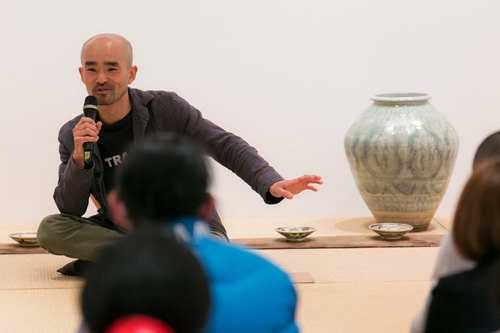
Recently, a live talk was held between Takashi Murakami and ceramic artist Aso Kojima.
The evening began with Kojima discussing his background and the path which led to his current practice and lifestyle. For his part, Murakami relayed the story of how he first encountered the artist and his work.

Following introductions, Murakami set the theme by asking Kojima to discuss the core creative elements required to aspire to and achieve standing as a ceramic artist.
In response, Kojima began by discussing his junior high and high school days, the period when he first became interested in a more ‘agricultural’ lifestyle.
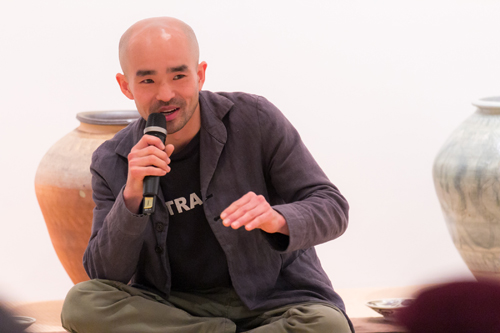
Kojima explains the problems he had with the average high school education.
One of the most touched-upon aspects of Kojima’s practice is the way he divides his time between tilling a sustainable farm and making pottery. His creative engine truly runs 24/7 and the seeds of that vitality were planted well into his teens.
Continuing his story, Kojima relayed how he was influenced by the TV drama “From the North Country” and began attending a boarding school in Yamagata dedicated to dairy farming. His interest in the school was initially peaked by a newspaper article in which staff from the school professed that “class curves are not what is important”.
After reading the article, Kojima immediately went to visit the campus with his parents but upon gaining entrance, he discovered that the reality was far different from the philosophy discussed in the article. Most students were still proceeding along the same path as at other schools. Unable to wrap his mind around the absurdity of the system, he considered dropping out but soon reached the unique conclusion that announcing his departure from a school which he had sought entrance to of his own volition would be equally absurd. Instead, he spent a year submitting blank answer cards for his tests, hoping this would lead the school to throw him out themselves. His wish was soon granted; he was expelled and returned to his hometown. From here, however, the narrartive takes a dramatic turn.
After leaving, the story of Kojima’s opposition to the school’s hypocrisy began to spread, finding support among his classmates, teachers, and even the parents of other students. Before long, a movement was born in opposition to his expulsion and it was, in fact, removed from his record. Surprised and moved to discover such support from those around him, Kojima reconsidered his actions and returned to school, eventually graduating.
As you can see, we are dealing with quite a formidable character.
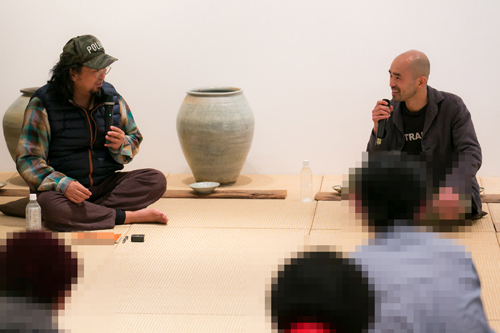
After graduating from high school, Kojima hitchhiked around Japan visiting and apprenticing on various farms until he had the know-how to make a living on his own. He estimates that he carried out hundreds of different tasks during this time.
Kojima’s journey ended in the Kyushu town of ○○, where he encountered a ceramic artist and saw his way of life first hand. Though he was intrigued, he did not immediately become an apprentice but rather spent 20 days helping the artist dig a hole for a new kiln. During this time, he began to seriously consider studying pottery himself.
As seen in “From the North Country,” Kojima’s goal was to live a life in nature. After intentionally pushing for his own expulsion from school, being recalled by his classmates, graduating, hitchhiking, and carrying out practical training, his next big step was to marry and father children…
During the interval, he read philosophy books and began to weave the strands of his future lifestyle, growing his own food and creating his own vessels to store and serve it. In doing so, he followed the precepts of Yanagi Soetsu’s folk art movement and established his works as low or common, rather than high art, a concept which allowed him to begin experimenting on his own. Having always been wary of the system of teacher and apprentice, Kojima approached all aspects of his new practice from his own unique philosophy. He made art objects, built and destroyed kilns, carried out exhibitions, and even built his own gallery. The works on display in this exhibition at Kaikai Kiki gallery are truly an extension of that history.
Touching next on the show itself, Kojima explained that the over 1000 works presented in the show were all made from different methods and this stemmed from a personal policy of constantly seeking something new and entertaining. For every 100 pieces he creates, only 30 percent see the light of day, meaning that 70 percent art destroyed and only the best are exhibited. By selling works of such admittedly refined quality, Kojima also acknowledged, with a smile, that he is in some ways challenging the core of the folk art concept. Still, if his production success rate increases, he will be able to support his family of 6 while still maintaining his current prices.
Truly , Kojima is an artist who holds his work, daily life, and everything that touches it to a higher standard and we were grateful to hear his perspective.
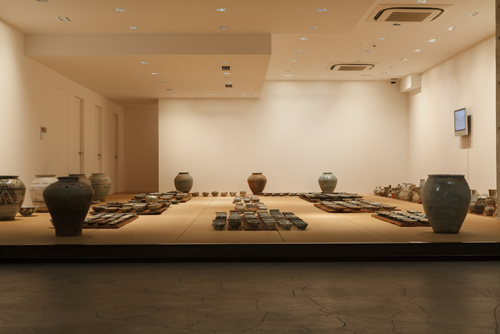
Lastly, Kojima identified the theme of this new exhibition as ‘vases’. He explained that when selling works at galleries that specialize in pottery, his large vases often go unsold, but given the larger scale of the space at Kaikai Kiki Gallery, he felt this time they would be appropriate.
Since September on, he has fired his kiln ten times and made over 3000 new works, of which 1126 were deemed fit for exhibition.
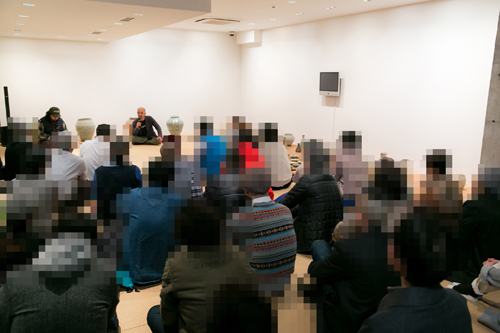
Guests listen intently to Kojima’s words
With the talk concluded, we opened the floor to questions from the audience and Kojima gave these final words:
“Rather than trying to address all my problems through money, I’ve instead focused on value as it relates to work, such as by making the tools I use myself and taking responsibility for their quality. Living that sort of life is what’s important to me. Because I focus my life on what I like to do, the training and physical exertion required is both an atonement and a form of confession.”
Next Spring, Kaikai Kiki will release a book of photos which capture Kojima’s daily life and work. We hope you look forward to it.